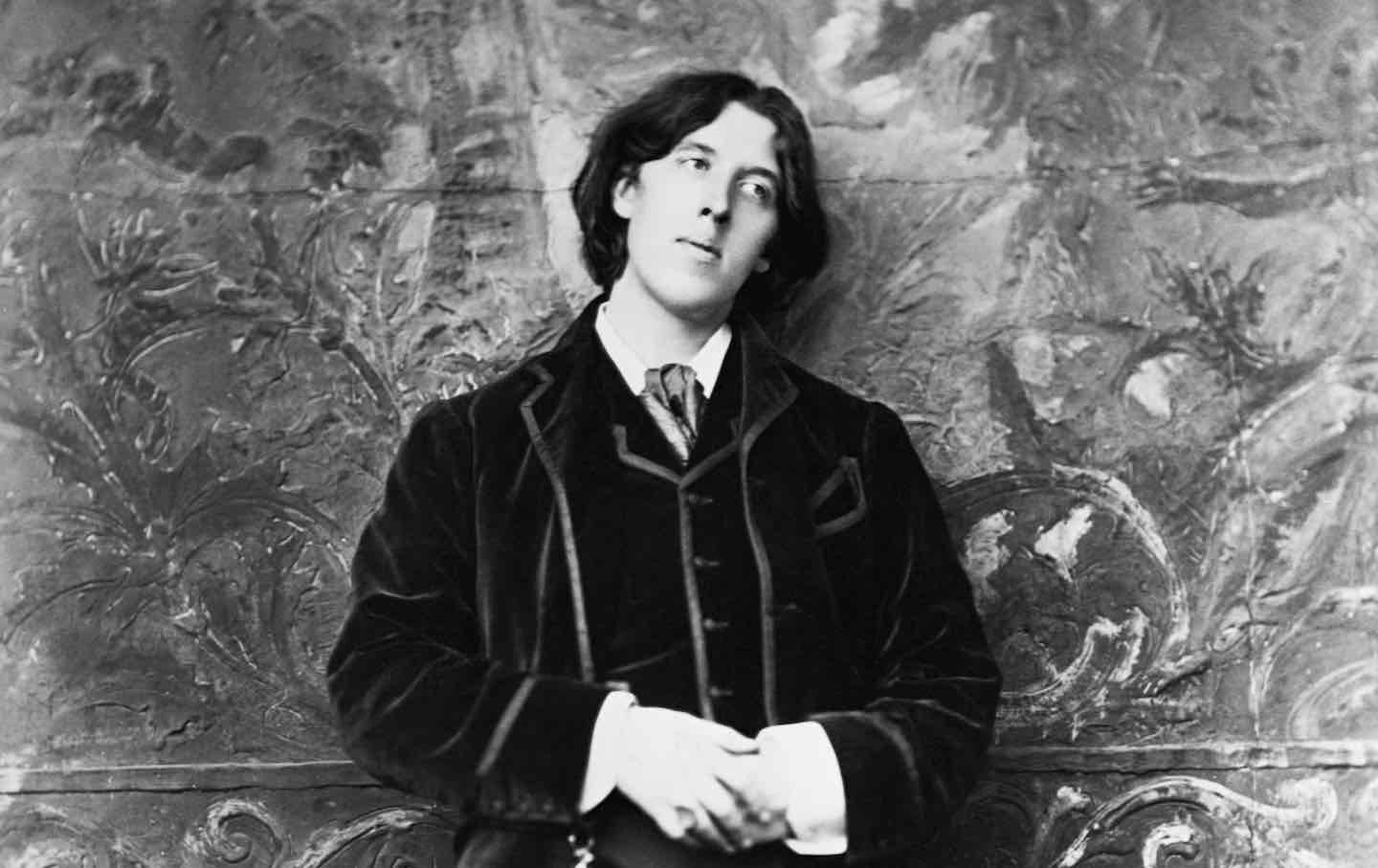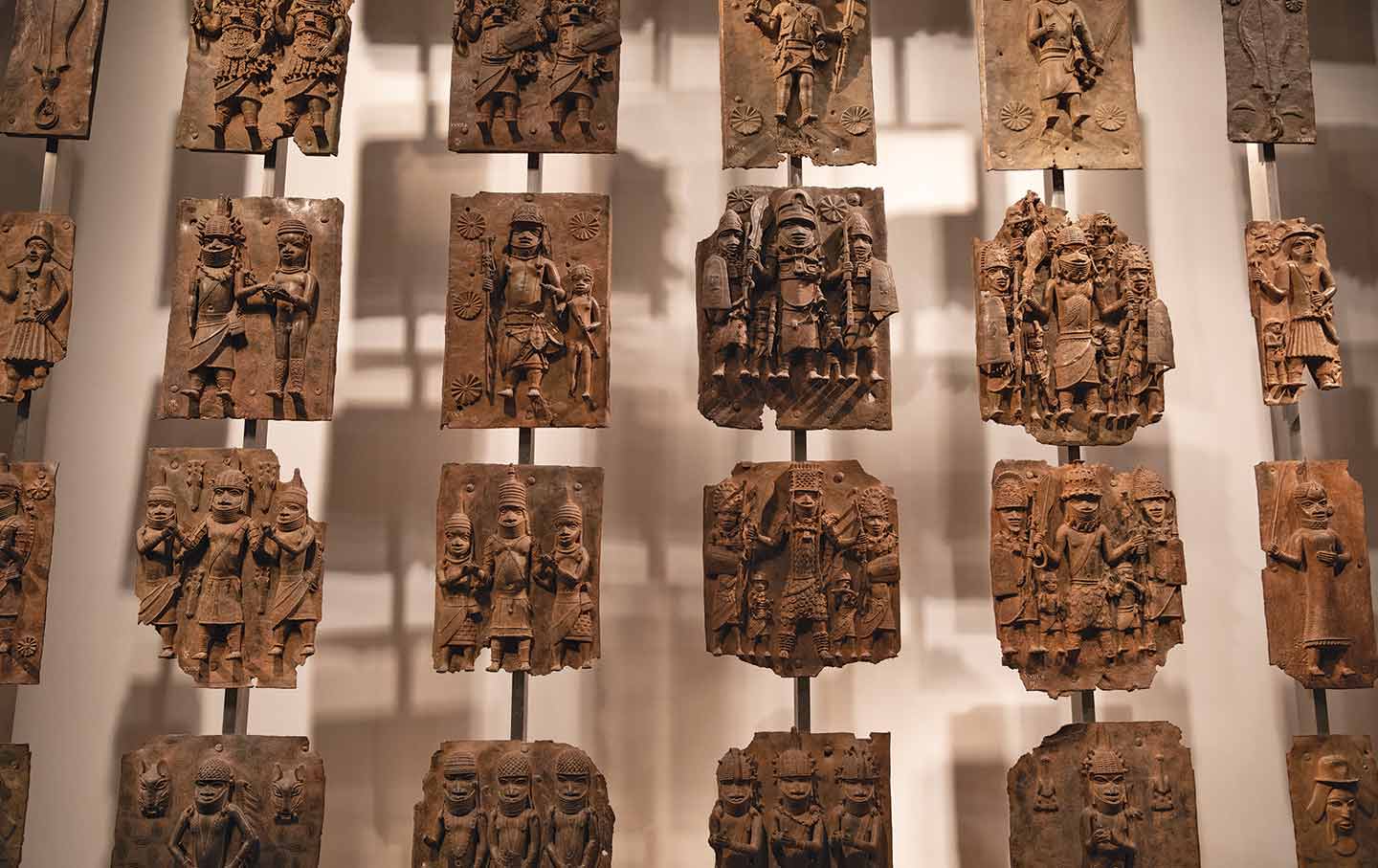Oscar Wilde’s Art of Disobedience
Revisiting his critical writing, we learn a valuable lesson about the critic’s role in refusing bad taste and bad politics.

“Disobedience, in the eyes of anyone who has read history, is man’s original virtue,” Oscar Wilde declares in his 1891 essay, “The Soul of Man Under Socialism.” “It is through disobedience that progress has been made, through disobedience and through rebellion.”
Books in review
The Critical Writings of Oscar Wilde: An Annotated Selection
Buy this book“Classic Wilde,” you might think. Isn’t it like him to argue that the betterment of civilization depends upon misbehavior? Since his death in 1900, at the age of 46, the writer’s popular image as a provocateur has only strengthened, and not without cause. In Wilde’s oeuvre, contradiction is not merely a rhetorical attitude, but an implicit intellectual challenge. Yet as a critic and essayist, his commitment to insubordination is also entangled with a lifelong philosophical inquiry into the conundrum of creating art on one’s own terms, unburdened by the demands of public opinion or by a milieu’s prevailing aesthetic conventions. If yielding to authority was tantamount to degradation, as Wilde believed, beauty and art could flourish only in conditions of freedom, which by his own definition constituted a utopia of socialist hedonism. “Man is made for something better than disturbing dirt,” he writes. Rather than brute, “unintellectual” labor, human life ought to be occupied by the sorts of activities likely to draw accusations of idleness: creative pastimes of one’s choosing or absolute contemplative leisure.
His body of criticism, newly collected in The Critical Writings of Oscar Wilde, cultivates an aesthetic of disobedience. Its language—sly, limber, epigrammatic—models the same rebellious individualism that it so fiercely advocates. In this annotated volume, editor Nicholas Frankel assembles a selection of Wilde’s most famous nonfiction writing, largely devoted to the matters of how an artist creates art and how others should receive it. Frankel divides this collection into four chronologized groups: reviews, essays and dialogues, letters to the press, and epigrams and paradoxes. Together, they illuminate a swaggering intellectual career that spans not just the novel, the play, and the poem but also, to a prodigious degree, the periodical.
As Frankel suggests in his introduction, “Wilde approached the writing of criticism with wit, irony, and a consummate sense of style, so much so that his critical writing is often hardly recognizable as criticism.” This flouting of rhetorical custom may itself be understood as a subtle form of defiance: a commitment to submitting language to a laboratory experiment of Wilde’s own devising. Take, for example, the argument that human progress requires disobedience, in which he invokes the latter’s “virtue,” as if the point of his writing is to yoke opposites, arousing tension through their unexpected alliance.
Wilde was no stranger to tension, or to scandal. The chutzpah of his criticism issues from his enduring friction with the cultural habits and assumptions of late Victorian England, from his resistance to complacency within a context he found sorely wanting. Yet inside that raucous rebellion, one cannot but discern a yearning impulse: that to obey, or not, could finally diminish as relevant modes of sociality; that an individual—queer, Irish, aesthetically flamboyant—could commit himself to beauty amid the peril fomented by an anxious nation scouting out transgression on every page.
By the late 19th century, Great Britain’s literary ecosystem was populated by a roster of venerated critics: Thomas Carlyle loomed large in the field, his sway unhindered by his death in 1881. Matthew Arnold’s 1865 essay “The Function of Criticism at the Present Time”—which Wilde would take to task 25 years later—famously champions the work of critics as crucial to literature in the wake of much public disparagement. John Ruskin and Walter Pater played crucial roles in art history and aesthetics, and each was uniquely indispensable to Wilde’s own thinking. But whatever intellectual debts Wilde owed to his critical forebears, he would not compound them through stylistic mimicry. Even the most recreational readers of Wilde could not confuse him for the author of The Stones of Venice (written by Ruskin in 1851) or Studies in the History of the Renaissance (written by Pater in 1873, and often referred to by Wilde as “my golden book”). Nor did the figure of “the critic,” chiseled in the Victorian imagination as a Carlyle-like symbol of sober wisdom, appeal to Wilde’s puckishness.
While he delighted in the role of the critic, Wilde was the first to admit his own limits. A critic cannot confer truth to his readers, nor should he attempt to do so, Wilde argued. At most, a critic can propose the terms of conversation. He implies that the power of language is essentially dialogic; it draws significance through its summoning of oppositions. Frankel delineates this impulse in Wilde’s criticism, identifying it as a proto-Bakhtinian “dialectical understanding of the truth”—an understanding that renders proof and reliability as red herrings. “No artist desires to prove anything,” Wilde asserts in the preface to The Picture of Dorian Gray, for “even things that are true can be proved.”
To scout out the precise coordinates of Wilde’s critical inconsistencies would be to miss his greater rhetorical point. (“Who wants to be consistent?” asks Vivian in his 1889 dialogue, “The Decay of Lying: An Observation.”) Still, his mercurial tendencies were not always choreographed. Early in his career, Wilde argued that artistic self-sufficiency existed in autonomous relation to one’s milieu. “Such an expression as English art is a meaningless expression,” he told the Royal Academy’s art students in an 1883 lecture. “Nor is there any such thing as a school of art even. There are merely artists, that is all.” Like the Greek deities depicted in Wilde’s beloved Hellenistic sculpture, artistic sensibility is born unto the artist with inviolable sanctity; it is a tidy, closed system, he suggests, dependent only upon itself.
Yet within two years’ time, Wilde changed his mind and began to acknowledge, even to insist upon the significance of cultural context. “An artist is not an isolated fact,” he writes in “Mr. Whistler’s Ten O’Clock” (1885), a withering review of the American painter’s lecture on aestheticism; “he is the resultant of a certain milieu and a certain entourage, and can no more be born of a nation that is devoid of any sense of beauty than a fig can grow from a thorn or a rose blossom from a thistle.” Wilde had once counted James McNeil Whistler among his friends, but the affection between them soured as Wilde’s views shifted to an irreconcilably opposing position. One blistering point of contention regarded the critic’s role in artistic discourse. In his lecture, Whistler laments the scourge of criticism, condemning its practitioners as “the middleman in this matter on Art.” Criticism, in Whistler’s estimation, amounts to little more than static interference: “It has widened the gulf between the people and the painter, has brought about the most complete misunderstanding as to the aim of the picture.”
Wilde saw the matter differently. He also knew that Whistler had long harbored a grudge against Victorian critics. In 1878, Whistler had filed a libel suit against Ruskin for a mean review. The artist won the case, although the jury conveyed its disdain for the proceedings by awarding him only a farthing in damages. Nonetheless, as Frankel writes in his introduction, the ruling in such a public case imperiled the critic’s “hitherto unquestioned authority.” The case implied the triumph of the artist over the critic, which is a constant conflict that still produces a thorny question: Why should critics possess the authority to critique art they did not create?
Wilde pokes at this question in “Mr. Whistler’s 10 O’Clock” and attempts to settle it through a shift in vocabulary: “I say that only an artist is a judge of art…. For there are not many arts, but one art merely: poem, picture and Parthenon, sonnet and statue…he who knows one knows all.” This statement foreshadows a more explicit moment of philosophical departure, in which Wilde demands criticism’s recognition as an aesthetic equivalent to other artistic forms. Even Matthew Arnold, one of criticism’s most famous defenders, had declined to make this leap: “The critical power is of lower rank than the inventive,” he admitted. Arnold’s critic does not create art but instead evaluates, assembles, organizes.
Popular
“swipe left below to view more authors”Swipe →Although an admirer of Arnold, Wilde could not abide what seemed to him a diminishing of the critic’s role. A critic was no mere lens by which to reflect a superior creation, nor a pale imitation of literary artistry. The cultural contributions made by critics warranted appreciation on their own terms. Wilde issued his own apologia in 1890 by way of his famous dialogue, “The Critic as Artist: With Some Remarks on the Importance of Doing Nothing.” Initially titled “The True Function and Value of Criticism,” it delivers a pointed refutation of Arnold’s thesis.
The conversation unfolds between Wilde’s slick, in-dialogue proxy, Gilbert, and his skeptical interlocutor, Ernest, who feeds Gilbert a handy supply of queries and protestations that incite his elaboration on the art of criticism. “You seem to me to be allowing your passion for criticism to lead you a great deal too far,” Ernest protests. “For, after all, even you must admit that it is much more difficult to do a thing than to talk about it.” Gilbert, who shares the author’s love of sly contradiction, is prepared for this moment, epigrams loaded in his quiver: “Not at all. That is a gross popular error…. Anybody can make history. Only a great man can write it…. [Action] is the last resource of those who know not how to dream.”
Here is a defense of criticism that refuses all prior terms and is shaped instead by Wilde’s own pleasure-centered metric. Loath to accommodate an industrializing empire’s fetish for productivity, he casts the writing of criticism in opposition to exertion of any sort. As Gilbert and Ernest debate, they gaze at the night sky, where “the moon…gleams like a lion’s eye”; Egyptian cigarettes dangle from their fingers. As Frankel notes in his introduction, “The critic is an artist, to be sure, but he is also a corporeal creature, whose thoughts and ideas are extensions of his physical life, not a repudiation of it.” In the domain of Wilde’s dialogues, his speakers are at liberty to enact the conditions that Wilde understands as central to creative work. If it is the critical instinct, not the creative one, that breeds innovation, then the critic requires the stillness afforded by “doing nothing”—by settling into one’s flesh and heeding one’s own impressions, wherever they meander.
Gilbert’s position in “The Critic as Artist” is seductive, but it courts disagreement. When I’ve read this dialogue in the past, my reactions have sometimes eked into Ernest territory. One could dispense with Arnold’s solemn distinction between critical and creative abilities without landing where Wilde does. But why would one read Wilde in pursuit of intellectual mitigations? Rather, one turns to him because the extravagance of his theories begets the most enthralling possibilities. Or as Gilbert concludes, “To the critic the work of art is simply a suggestion for a new work of his own, that need not necessarily bear any obvious resemblance to the thing it criticizes.”
There are a few peculiar lines at the conclusion of Wilde’s 1885 essay, “The Truth of Masks: A Note on Illusion,” in which he offers a sly disclaimer to the argument he would make five years later:
Not that I agree with everything that I have said in this essay. There is much with which I entirely disagree. The essay simply represents an artistic standpoint, and in aesthetic criticism attitude is everything.
The critic shoulders many artistic and intellectual responsibilities, but always saying precisely what one believes is not among them. As the essay’s title implies, a writerly posture—a linguistic mask—might signify more than any so-called authentic claim. Performance, Wilde knew, was a reliably tangible fact of existence; another person’s truth was a glint on the horizon, easily contested and endlessly deferred.
In April 1895, during Wilde’s failed libel case against the Marquess of Queensberry, he was questioned about a line in his series of epigrams, “Phrases and Philosophies for the Use of the Young” (1894): “A truth ceases to be true when more than one person believes it.” Wilde explained that according to his “philosophical definition,” truth was “something so personal…that in fact the same truth can never be apprehended by two minds.” The court could not abide such vast ideological diversity, particularly when posited by a man who, soon after, would be convicted of gross indecency for homosexuality. Wilde’s truth—and his adherence to it—yielded criminal condemnation and punishment: It signified an illicit, unpardonable refusal.
In “The Critic as Artist,” Wilde also invokes the matter of necessary disobedience, although he draws on more strident language than he does in “The Soul of Man Under Socialism.” “What is termed Sin is an essential element of progress,” Gilbert declares. But lest the reader misinterpret the remark as equivocal, he presses the point: “Without it the world would stagnate, or grow old, or become colourless…. In its rejection of the current notions about morality, it is one with the higher ethics.” Perhaps these lines comprise a kind of beatitude, uttered for those who, like Wilde, resisted impossible assimilatory demands. Or perhaps they’re a nudge to the docile reader: The only route to Utopia is illuminated by disobedience.
More from The Nation

The Agony of Aaron Rodgers The Agony of Aaron Rodgers
Is he the world’s most interesting athlete or is he just a washed-up crackpot?

Can You Understand Ireland Through One Family’s Terrible Secret? Can You Understand Ireland Through One Family’s Terrible Secret?
In Missing Persons, Clair Wills's intimate story of institutionalized Irish women and children, shows how a family's history and a nation’s history run in parallel.

Peter Schjeldahl’s Pleasure Principle Peter Schjeldahl’s Pleasure Principle
His art criticism fixated on the narcissism of the entire enterprise. But over six decades, his work proved that a critic could be an artist too.

How the Western Literary Canon Made the World Worse How the Western Literary Canon Made the World Worse
A talk with Dionne Brand about her recent book, Salvage, which looks at how the classic texts of Anglo-American fiction helped abet the crimes of capitalism, colonialism, and more...

Along the Roads That Built Modern Brazil Along the Roads That Built Modern Brazil
José Henrique Bortoluci's What Is Mine tells the story of his country’s laborers, like his father, who built its infrastructure, and in turn its fractious politics.

The Long History of the "Elsewhere Museum" The Long History of the "Elsewhere Museum"
Can the ethnographic museum be reinvented?


